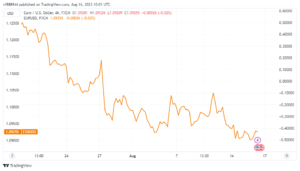EURUSD stabilized above 1.0900.
The EURUSD recovered over 1.0900 after falling to its lowest level in five weeks near 1.0870 on Tuesday. If the pair can turn 1.0940 into support, it could prolong its rebound.
The EURO was under intense bearish pressure and fell below 1.0900 in the American session on Tuesday after US data revealed that Retail Sales grew faster than predicted in July. Later in the day, however, dropping US Treasury bond yields prevented the US Dollar from retaining its momentum, causing the pair to reverse its course.
Renewed Fears of a banking crisis in the United States prompted a drop in US yields after Fitch Ratings warned on Tuesday that it may cut the ratings of major firms.
The Eurozone GDP data for the second quarter were in line with market expectations.
Eurozone real GDP rose at an annual pace of 0.6% in the second quarter, according to Eurostat data released on Wednesday. This figure equaled the first-quarter growth rate and was in line with market expectations, so there was no noteworthy reaction.
Data on housing starts and building permits will be included in the US economic docket. The Federal Reserve will publish the minutes of the July policy meeting later in the session.
Market players are likely to remain focused on Wall Street. Despite the fact that the USD normally benefits from risk, Moreover, another episode of bank stock selloff might pull rates much down and impact on the currency.
Technical Analysis
The top limit of the descending regression channel hits the 20-period Simple Moving Average (SMA) at 1.0940, providing immediate resistance to EURUSD.
Once the pair breaks through that level, technical buyers may show interest, pushing EURUSD higher toward 1.0960 (50-period SMA), 1.0980 (100-period SMA), and 1.1000 (psychological threshold, static level).

If EURUSD fails to break beyond 1.0940, it might fall back to 1.0900 (psychological level, static level, mid-point of the declining channel), 1.0870 (August 14 low), and 1.0840 (lower limit of the falling channel).









